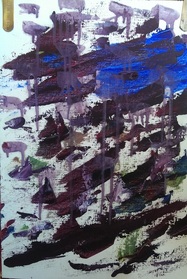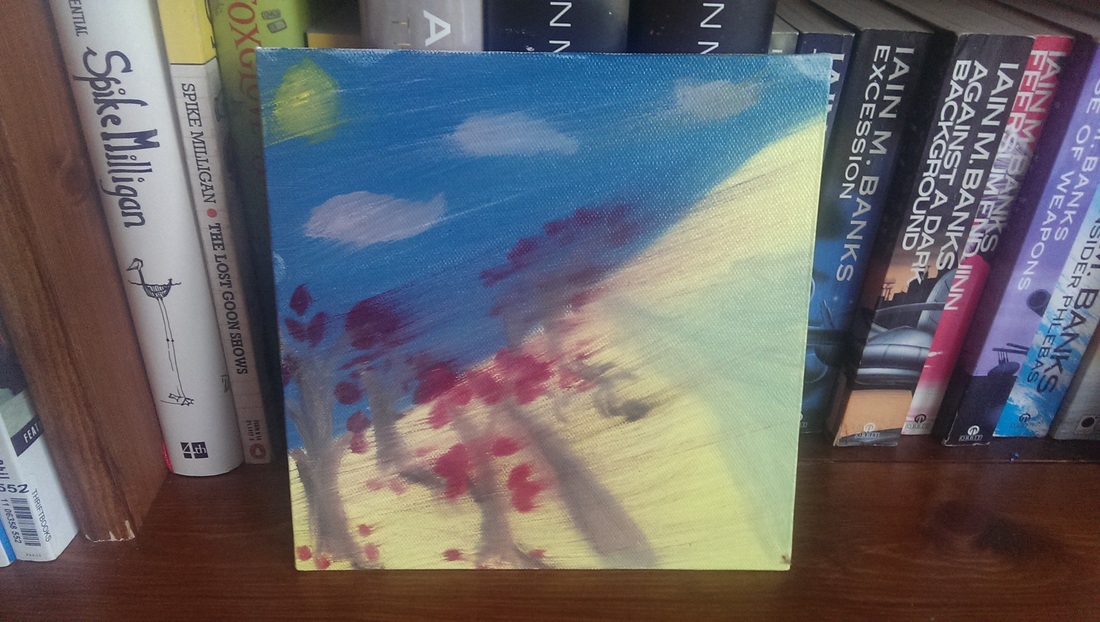0 Comments
The two pieces above were created at the same time. The one on the left is called "Train Journey in the Rain" and the one on the right, "Beach Holiday". The one on the left was created as a consequence of the one on the right.
The process usually works like this. I plan a work. The theme is usually a still life in an unusual setting, of which Beach Holiday is a prime example. There is always a point when painting something like this when I have to stop before you can continue, either because I have run out of time or the paint needs to dry before I can continue. Then I set myself the task of using a painting knife and the left over paint of creating a more instinctive abstract piece. It is an interesting and engaging tactic. Thus one main piece can generate several companion pieces. This time it was different. My method of painting has change. I still uses brushes, artist medium and terps with which to paint. I have however become slower and more thoughtful. I take longer on my paintings and simply apply more paint. A consequence of this was that during the creating of Beach Holiday no Left over Paintings were created, until the end. At the end of Beach holiday, I was working on the beach, adding depth and complexity. This left me with allot of unused blue and read. And so Train Journey in the Rain was born. I liked the idea that this was perhaps the journey to the beach. I wanted to capture the passing lines of a train journey. I used a small triangular knife to drag the pain across the canvas. Previously I have only ever used left over paint. This time however I hit upon the idea of using the left over artist medium to create a rain droplet effect by depositing diluted paint on the canvas and letting it drip down the canvas. I am very pleased with the result. I am also pleased with the result on Beach Holiday. The extra paint gives it more of an internal glow. I hope you like it to. By special request of one of my readers, this post covers again the Royal Academy.
If you haven't been then it is worth going to and is easy to get to. It is a short walk from Piccadilly station just past the splendid Burlington Arcade and opposite Fortnum and Mason's. A hint. If you arrive on the hour you can see the Fortnum clock and two automata emerge from in 18th century dress and nod at it each other. The Royal Academy is inside an impressive archway, on a site that it shares with a number of other societies such as the Royal Society. There is nearly always an installation in the courtyard. At the moment is a monumental Iron structure, reminiscent somewhat of three blooming overly regular flowers by one of the RA's members, Conrad Shawcross. It is at its best in bright sunlight when the shadows on the paving are intriguing. There is nearly always an exhibition on. At the moment it is the Summer Exhibition which I have written about previously (see my previous post). The exhibitions are quite pricey unless you are a friend of the academy (when they are free) or have some kind of concession. I have an art pass which gives me 50% off there and most other galleries. However you can nearly always go in anyway and the building, in its 19th century grandeur is well worth seeing. At the moment there is a free exhibition on by Eileen Cooper. Have a look if you can. If you are there for a paid exhibition take a look afterwards. The calm consistency of a single artist exhibition makes for a nice counterpoint to the hectic summer exhibitions. Through three rooms all the works have a very similar style. Mainly black and white with naïve bold strokes in I think charcoal (or similar) with characteristic over large head and features. It is all relatively recent works so it is not like other exhibitions where you get a retrospective with changing styles. Interesting none the less. Three works stood out for me. In the first room next to each other there is a woman with a tiger (a common theme) and next to that a man with an elephant. They are witty and striking pieces. By far my favourite though was a picture of the artist’s studio. This is positively funny (in the best possible way). I particularly enjoyed the representation of some of the other works on display in the background of the piece. If you do go, look at the ceiling in the third room. You won't be disappointed. This Wednesday I attended for the first time the summer exhibition at the Royal Academy.
From the account of previous years and the general public perception I was expecting a vast array of rooms, floor to ceiling with art work, much of which would be of questionable quality and submitted by the general public. Perhaps it has been this in the past but certainly not this year. There was less art on display than I was expecting although saying that there were over 1000 peices. It was also of high quality and much of it from estalished artist and RA members. I realised I would have to be lucky, or it would be some years before I would have a chance of being on display there. The work was nicely arranged so it did not overwhelm you and you could focus on individual peices. Of unexpected interest were the architectural peices, particularly of the Thames Bridge but for me the stand out artist (and for me at least a new discovery) was Barbara Rae. Her highly colourfull and striking works appealed to me greatly. A very good use of colour. Sadly all out of my price range. It was interesting to see what sold well. Good, relatively cheap peices which also came with editions of prints had a multitude of red dots. The most I saw was on a painting of a Dachshund. If you have a interest in art I suggest you go. If you are an aspiring artist then it is well worth a visit. It give you a very good idea of the standard required and the state of the market. What was your favourite? Sometimes I have a clear direction of what I am going to do with my painting such as the maxi mix paintings. On other occasions such as the painting pictured above, I have no goal in mind but just paint almost on instinct. Every so often this works out well with a striking and interesting painting such as the Ostrich Egg.
Most of the time while the instictive paintings give rise to some interesting effects or ideas that I can use elsewhere I usually find them less satisfying to do and am less pleased with the results. From this one, the composition is a little weak. I like the contrast of the red on the yellow but the main thing I have taken from this is the windblown effect, using a fan brush. It is a usefull way of capturing movement or out of focus which I will probably build into something else in future. Do you find a planned painting is more effective? I'd be interested to know. |
Archives
June 2024
Categories |





 RSS Feed
RSS Feed